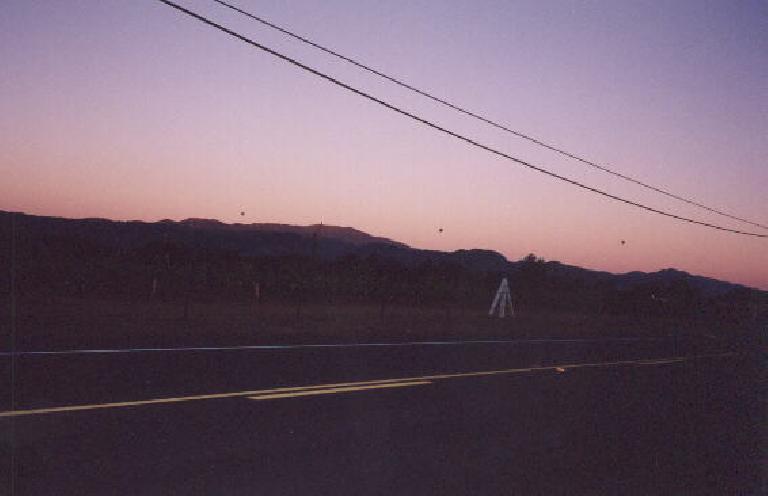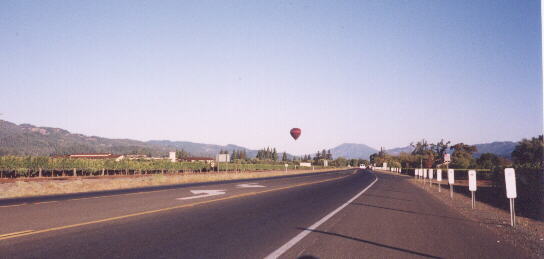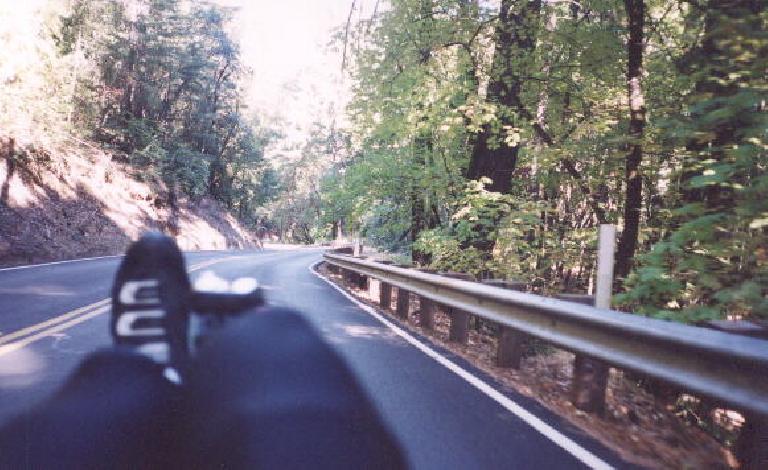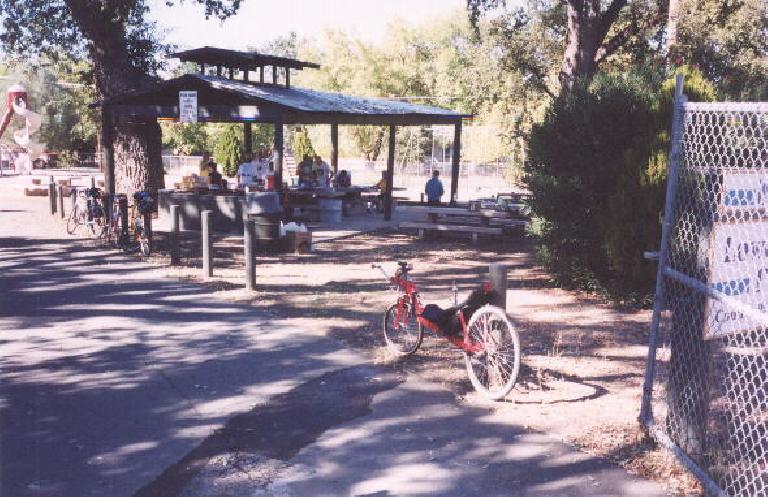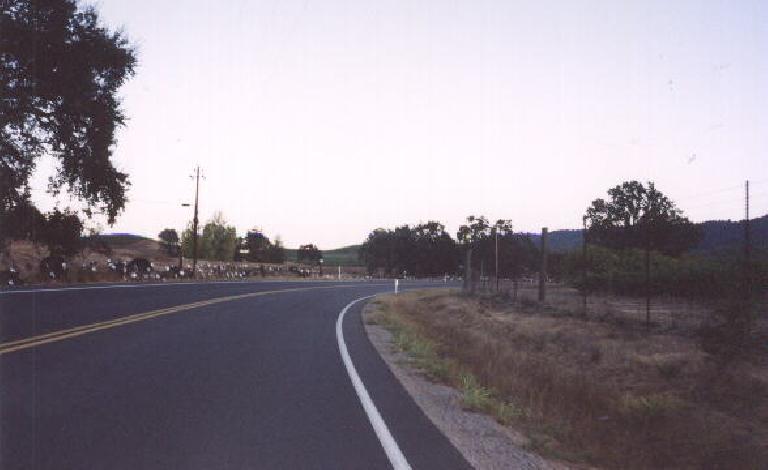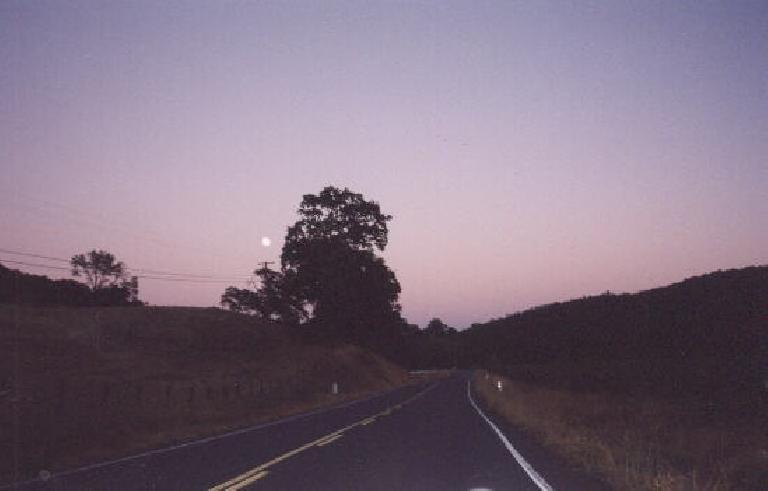Knoxville Double Century
“The most important thing to learn from history,” a history teacher once told me, “is that history has a tendency to repeat itself.” And so was the case of the 2001 Knoxville Double. Last year I had done the same 200-miler on a significant other’s birthday, and this year I would do it on my mom’s birthday. Both rides would be done on my recumbent as opposed to my better-climbing, but less-aerodynamic diamond-frame bike, with beautiful weather and gorgeous scenery of Napa County. And by doing this ride I had once again “unretired” from ultramarathon cycling, the last retirement coming immediately after April’s brutal Devil Mountain Double.
There was also a repeat of my double-century pre-ride tradition. Starting with the 1997 Death Valley Double I had done last-minute repairs or upgrades to my bicycle that often were both untested and too-close-for-comfort . Having learnt from those experiences I fully intended to do bicycle maintenance a full week in advance, but the busy events of the preceding week once again left me tinkering in the garage the night before the race. This time I adjusted the rear derailleur, lubed the chain, and replaced the synthetic sheepskin cover on my recumbent’s seat with 3/8″ closed-cell foam from Orchard Supply I had cut to size.
There was also another pre-ride tradition I had inadvertently tended to, too: sleep. Or lack of! Two nights before the race I was out in SF until 2:00 a.m. (getting to bed at 3:00 a.m.), and the day before I had worked until almost 8:00 p.m. before working on my bicycle. I was on the road to Vacaville by 11:00 p.m., and arrived at the Lagoon Valley Park at 12:50 p.m. As the gates to the park were closed I drove the Z3 offroad, parked, and promptly fell asleep in the non-reclining driver’s seat. I’d awaken by 4:00 a.m., when my alarm went off and when a ranger soon after came up to my window with a flashlight. “Is there a bike race going on?” he inquired, alluding to a steady stream a cars coming in with bike. I replied in the positive and gave him some details. 200 miles, over 12,000 feet of climbing, all within one day, starting in just an hour. Pretty crazy, I’m sure he was thinking!
The Ride
The ride began in darkness, as I started at 5:10 a.m. Several cyclists had already left as there was no mass start. I quickly came into contact with a small group, though rode far enough behind them so that I would not be in their draft.
Drafting is an integral part of true racing, a critical element in race tactics, and a riding technique that effectively reduces one’s effort by up to 25%. Everyone does it. Yet I’ve always hated it, not just for the inherent risks involved in doing so (i.e., crashes), but because it inhibits one’s view and forces one to ride at other people’s pace. To me it also seems to diminish (if only slightly) the accomplishment of riding 200 miles. Anyone, assuming there are insignificant hills, can draft for 200 miles, but can he or she do it without the help of another rider? Personally I prefer to ride out in the wind by myself even if it means a slower time, as at least I’d know I could do the entire distance alone. To each his own.
In any case, with my recumbent drafting is almost a non-issue. There is not enough cross-sectional area to provide a significant draft for riders behind, and the aerodynamics of the ‘bent are so superior that it’s almost like drafting to begin with. However, to offset the better aerodynamics is the higher weight (about 6 lbs. more compared to my Cannondale) and worse biomechanics for climbing. On a flat or rolling course a recumbent is faster than a traditional diamond frame; on a hilly course it’s slower.
Based on that premise, my strategy was to take it easy in the first half of the race, where most of the climbing took place, and make up time in the flatter second half of the race, where my recumbent theoretically had the advantage. In fact this was the strategy I had last year, but disregarded upon meeting Sandra, a 40-year-old rider who was really lagging but I had agreed to ride with to the end starting at Mile 75 or so. Whether or not I would stick to this strategy remained to be seen later in the day.
Balloons, Wineries, and Sunrise
Not quite 1.5 hours and 25 miles into the ride came the morning’s greatest view: five colorful manned balloons drifting over wineries, with a pink sun peeking over the mountains to take a look itself during this glorious September morning. This is California at its finest!
Alas, these thoughts were interrupted when, after the first rest stop, I missed a turn by 2.5 miles. Actually, I had lost my map and was unaware of this, until some other riders ahead turned around and yelled to myself and others a way behind, “I think we missed a turn!” After some discussion, we all turned around, though I quickly lose sight of the pack because… I crashed. My front wheel fell into railroad tracks that were nearly parallel to the road but I had to cross over them. As usual on the recumbent, however, I was already so low to the ground that when I fell, I did not get the slightest bit hurt! I did lose the gulp valve to my hydration pack, though, which at first I thought was disastrous until I realized the open hose was just like a straw which would allow me to have higher flow of liquid to my mouth!
Soon after this mishap I got back on course and started riding along the Silverado Trail. I had been here in March, running the Napa Valley Marathon. What a difference in the weather since March! Back then it was dark, windy, and very very wet. Memories came back regarding the last 3 miles of that race, in which my chances of beating George W. Bush’s best marathon time of 3:44 was lost, the rain was now beating at us horizontally, my body was becoming quite frigid, but I still managed to fight to the finish to come in under 4 hours by a mere 53 seconds. It was a good race. But I digress.
Just ahead on the other side of the road, however, were runners wearing numbers just like us cyclists! Apparently, they were doing some sort of relay. There were perhaps at most 175 of them, just like the number of cyclists participating in the double.
More great scenery: Lake Berressa, a few more wineries, much less cars. The terrain turned slightly upward, though gradually. The course actually did not look too familiar at all despite riding it last year. The last gradual climb to Rest Stop #2 was starting to take something out of me, as a couple of riders were able to catch and drop me. Yet I arrived at the rest stop about 45 minutes before the time cutoff, and perhaps 15-20 minutes before last year. My body felt better than last year, too!
Grind Time
“It seems to be mostly up,” a staff member replied when a fellow rider inquired about the next leg. “It’s the hardest part of the course.”
I had read about this, and in fact I had ridden it last year. Yet, my memory failed to recall exactly how hilly it was, especially since last year I was riding with Sandra, and we kept stopping/resting along the way. I do recall feeling fairly good, often getting ahead of Sandra despite being on a bike that can’t climb as well as her diamond frame. So what was in store?
Another rider I had caught up to asked me if there was an upcoming water stop at the top of one of the upcoming climb. I could not even remember a water stop from the last year! Having filled up my hydration pack with 60 or so ounces of water, there was no way I was going to stop at the water stop if it existed, I resolved.
Hours later the water stop finally came. I was struggling on the climbs. I was tired and had drank A LOT of water that was in my hydration pack, made easier by having lost that gulp valve after the crash in the morning. Yet I did not stop and fill up.
Lunch was just 10 miles away, I knew. It did not occur to me that when one is climbing at just 4 mph, 10 miles actually is a Very Long Distance.
What did this all lead to? Dehydration!!!
History had repeated itself once again. I thought of the 1997 Death Valley Double again. The 1997 Foxy Fall Classic. Well, at least I had survived those.
Somewhere in this leg of the ride, actually before this moment, I was actually sighted by another rider.
“Did you ride the Death Valley Double on that bike?” he asked.
“Actually, yes, in 2000,” I replied.
“Yes, because there’s a guy who has a web page that has stories of all of the rides he does. He does about half of his rides on his recumbent and half on his regular bike.”
“That is probably me,” I replied. “Although I’ve done 14 doubles on my regular bike and 3 on my recumbent.”
“It’s a really nice web site, as it really embodies the spirit of double centuries!” he generously remarked. Cool!
Our conversation did not last long, however, as he was clearly climbing better than I. Within 10 minutes he was out of sight.
Finally, a downhill. 48.5 mph! But at that speed the descent doesn’t last long. Just a couple of minutes. Followed by yet another long ascent.
Another downhill, and what seemed like an eternity… 3:15, into lunch! A little earlier than last year, but still, that’s about 4 hours since the last checkpoint that was 33 miles ago. It just underscores how much climbing was in that section of the course. Pretty brutal!
The Second Half
“You’ve done the hardest part,” one of the lunch staffer told the fellow riders around me, most of whom looked pretty wasted. “You’ve done 9600 feet of climbing already, with 3400 more to go.” (Which makes a total of 13,000 feet, not the advertised 12,000??)
I already could hear the gasps. 3400 feet more to go? “I really want to go down,” proclaimed a rider.
“You will! There’s just one hill you will do right after lunch that’s about 600 feet; Cardiac which is 400 feet, and some rollers of maybe 100-200 feet.”
That didn’t seem to allay too many fears among the cyclists although it made me much more optimistic!
However, that optimism was short lived. The “600 foot hill” turned out to be a meandering climb that was gradual but was an extremely rough road with short twisty downhill sections where not too much time could be made up. And it was LONG! I lost a lot of time here as others were dropping me. This was the low point of the ride as I was not feeling well at all.
After an hour the climbing was finally over and I tried to regain my composure. During that time I was conscious enough to at least drink a lot of fluid suspecting dehydration. I really was not well! But flat sections came and despite only going 15-17 mph I was starting to recover.
The next checkpoint was actually fairly close–just 27 miles from lunch. Most checkpoints were 35 miles apart. When I arrived I learned that there were still several behind me… not too far behind, but at least I wasn’t the last person out there yet!
A Change in Direction
My spirits now again up, I requested a Pepsi. I remembered how during this year’s Devil Mountain Double, I drank one in desperation, and it made all the difference in the last third of the race. I abstain from consuming caffeine except in the most critical of moments, and this was certainly one of them.
At this point many of the other cyclists were thinking slow and steady to the next checkpoint, where lights would be awaiting most of them. As it was almost already 6:00 p.m. and the checkpoint being over 30 miles away, I knew I would have to hammer in order to get there with adequate daylight still remaining. I was also tired of being near the tailend of the pack. But the course–which was not my recumbent’s preferred terrain all day–would suddenly be full of long, smooth, and wide flat and downhill sections, and it was my turn to make up some time!
I think the others realized that they had to get going, too, in order to get to the checkpoint safely without lights, as we all left after staying at the rest stop for 5 or so minutes. I let the others go ahead while I went to visit a tree to take a leak. Immediately I was back on the bike and the others were not out of sight yet. A short hill was up ahead where the others seemed to be bogging down on.
In contrast, I attacked!
At the crest of the hill I whizzed past by four of the riders out in front. I could see in my helmet mirror that two of them decided to take chase whereas the others are content at just going their own pace. The two riders stayed within perhaps 500 feet for a couple of minutes while we hit another roller, but as the gap isn’t getting smaller I was encouraged. Near the top of the roller I attacked again. Now they were long gone.
I got into a good rhythm, still well below my anaerobic threshold but spinning at 90 rpm and going about 30 mph. One of the support crew in a green Subaru wagon (who, I should mention, had offered GREAT encouragement and support all day and should receive some sort of award!) suddenly pulled alongside of me, and I give him a thumbs up sign. I think he was startled to see me hammering out there up front putting a lot of distance on the others, as the last 4-5 times he saw me I was clearly not doing so well. And there was still 60 or so miles to go with Cardiac waiting ahead. Undaunted, I continued the frenzied pace. The staffmember was driving alongside me for a couple minutes like he was clocking me. Finally, I pushed even harder, accelerating slightly ahead of the Subaru even at these speeds! Finally, he waved me off and his car accelerated well ahead of me… sorry, on flat roads even on my recumbent I max out at 35 mph or so.
I quickly passed a couple of more riders I had last seen hours ago, and for a long time, I was all alone in the middle of nowhere. Thank goodness it was almost impossible to get lost, basically taking the same road until the next checkpoint. I was still in a groove. The road looked familiar from the Davis Double Centuries I have done in the past. We even passed by the famous HubCap Heaven, a farm area with a fence lined with hubcaps.
Despite my frenzied pace full darkness did set in before reaching the checkpoint. This was fine since a near-full moon was out and there were not too many cars on the road, but closer to the checkpoint there would be more cars. However… 5 miles from the checkpoint someone in a car coming other way shouts at me, “I have your lights!” It was the staffmember in his green Subaru! He quickly gives me my lights and rushes off before I can really even thank him… he knew there were many others farther back on the course who could be in serious trouble without theirs. I hope everyone made it okay safely.
When I reach the checkpoint I have a hot dog and a cup of homemade chili. Yum. Less than 40 miles to go, and feeling great again.
To the End, in Darkness
The last two legs of the ride were memorable, if fairly uneventful. Even with lights one can’t really hammer in the darkness, and hence I settled into a “normal” pace. Just enjoyed the fine California night under the stars and moon. I had almost forgotten how nice it is to be out there riding along in rural areas in the late hours of the night, entirely peace with only the company of the chirping crickets and, of course, my bike. I had moments like this in my youth as my family lived out in rural areas, and enjoyed them. Back then I had dreamed of moments like this, and here I was, living the dream.
The night is good for bringing out emotions. Vision is reduced, but the other senses like sound, touch, and smell are enhanced. Not being to see everything around you forces one to look within. The environment otherwise unremarkable suddenly becomes surreal.
The batteries for my light are near-dead before the last rest stop, so I turned off my light to save the last few joules of energy for occasions like when there’s traffic and I wanted approaching drivers to see me. My blinking LED taillamp was still going strong as expected.
At the last rest stop I departed with a couple of other riders but again kept a pretty big distance behind them, not wanting to draft, and wanting to ride alone. Their rear taillights, however, served as a beacon of to where to go. Just down the road, over the highway, and into the park were the final directions for the race. It seemed to take a while but finally we could hear cars from Interstate 80 in the distance.
And so with the very last hill of the day–a trivial overpass on I-80, half a mile from the finish–I attacked, if only to signify to the mountains that despite holding me back the first 130 miles of the day, they could not hold me down forever, not today, nor tomorrow. For this has once again been proved by history.
Photos are here.
Ride Data
- 200 mi (5 due to getting off course)
- 5:10 a.m. start, 10:45 p.m. finish—17:35 hours
- Average Speed: 12 mph moving, 11.4 mph overall
- Max Speed: 48.5 mph
- Total Climbing: 12,000 feet
Rating
(5=best)
- Scenery: 5 Once again, some of the best that Northern CA has to offer.
- Support/Organization: 5. Road markings generally excellent; support was superb!
- Food: 4 The staff custom made sandwiches, and the chili at rest stop #6 was great.
- Weather: 4+. A bit cold in the morning but otherwise very nice.
- Relative Difficulty: 4
- Overall Rating: 5

